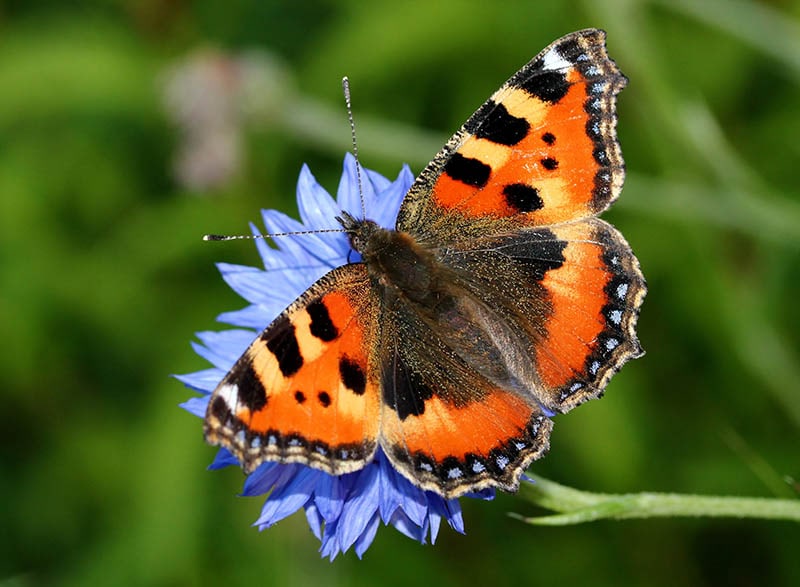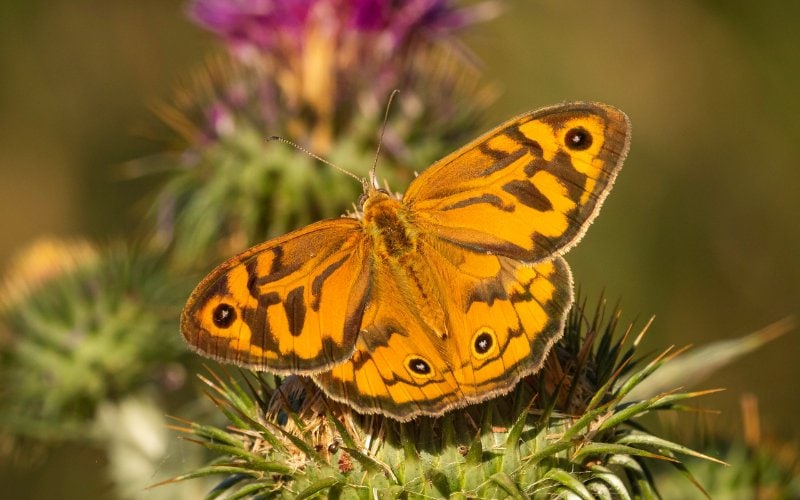How Long Do Butterflies Live? Life Cycle & FAQs
-
Kristin Hitchcock
- Last updated:

The lifespan of an adult butterfly can vary greatly from species to species but the average is only about 2–3 weeks. After becoming a butterfly, most species reproduce relatively quickly and then perish.
Of course, this does lead to some confusion with migrating species. While some species do migrate, individual butterflies do not migrate. Instead, large migrations occur over generations, with breeding occurring along the way. Therefore, migrations may take longer than a single species’ lifespan.
As cold-blooded creatures, butterflies rely on the surrounding temperature for survival. They cannot make their body heat and as soon as it starts to cool, most butterflies will perish.
Some species can go dormant, and a young butterfly hatched just before the fall may go dormant when the cool weather arrives. This individual may live many months, though it will be dormant for much of this time. Of course, only some species can go dormant. Others migrate, while some live in areas that are warm year-round.
Butterflies living in captivity may have a slightly longer lifespan. After all, they can be kept in an environmentally-controlled environment and are free from predators. However, butterflies are designed to have fairly short lifespans. Therefore, they usually don’t live much longer in any case.

A Butterfly’s Life Cycle
A butterfly goes through many phases before it becomes a butterfly. Therefore, the lifespan of an individual is a bit longer than only a few weeks if you also count the other phases.
How long each phase lasts depends on the particular species. Some species spend longer in certain phases than others.
Here are the averages for each phase to give you a general idea of how long each lasts:
- Egg: 4 to 10 days. The current weather can have a large impact on this timespan.
- Caterpillar: 3 to 4 weeks. The caterpillar will shed its skin many times while growing. Sometimes, this phase can be affected by food availability.
- Chrysalis: 10 to 20 days. Caterpillars must reorganize themselves into a butterfly inside of a chrysalis. (Butterflies do not make a cocoon, technically.)
- Adult stage: 2 to 3 weeks. During this stage, adults are mostly concerned with breeding.

What Affects a Butterfly’s Lifespan?
Many factors affect how long a butterfly may live. Different species have their average lifespans, but the lifespan of each butterfly can vary a lot.
Let’s look at some of the most common factors.
Temperature
Butterflies are cold-blooded, meaning they cannot produce their body heat. Therefore, if it gets too cold, they will perish. To combat this, some butterflies will migrate. These species may live a month or so longer than others, as they don’t have to deal with the colder temperatures. However, these migrations often take place over many generations.
In other words, even butterfly species that migrate don’t have very long lifespans. Temperature alone isn’t the cause for many butterflies perishing.
Genetics
Many butterflies are not meant to live very long. Even when cared for in captivity, where food and temperature aren’t issues, butterflies don’t have long lifespans. Genetics play a big role in how long a butterfly lives.
While many butterflies die of other causes, they also have a very short lifespan built into their genetics.
Size
Larger butterflies tend to live longer than smaller ones. Of course, species also matter. Larger species tend to live longer than others overall. But even within the same species, slightly larger butterflies tend to live longer.
This isn’t for certain, of course. Larger butterflies may be more likely to attract predators because they are more visible, which can lower their lifespan.
Environment
The area a butterfly lives can affect its lifespan in many ways. Beyond temperature, the density of predators and availability of food can change a butterfly’s expected lifespan. If there are more predators, the butterfly’s chance of being eaten is higher. Butterflies in areas with more competition for food may have lower average lifespans.
Pollutants and similar issues can also cause problems for butterflies. Therefore, butterflies may live less time in urban areas with more human activity. But it does still depend on the exact butterfly species and pollutants.
Urban areas tend to have fewer predators, as well. So while butterflies may have a reduced lifespan from air quality, it may be extended by the lack of predators.

Which Butterfly Species Lives the Longest?
Butterflies live for different periods depending on the species. The brimstone butterfly lives longer than any other species, and adults of this species can live for up to 13 months. They are found across many areas of Europe, Asia, and North Africa. They hibernate through the winter, which allows them to live much longer than other butterflies.
However, they spend little time active—most of their time is spent hibernating.

Why Are Butterflies’ Lifespans So Short?
There are a lot of dangers for butterflies. They must contend with predators, temperature issues, cars, and similar hazards. Therefore, the life of a butterfly is quite hard. Their lifespan isn’t very long because there are simply many things for them to overcome.
Furthermore, as adults, butterflies are solely trying to reproduce. That’s all. To reproduce, they only need to mate and lay their eggs. Butterfly adults do not need to stay around and raise their children like other species. Therefore, living longer does not do much to help further the species, so it isn’t something that they have evolved.
Instead, butterflies are around for a season, and then they give way to the next generation. In this way, butterflies just aren’t programmed to live very long. Even when kept in captivity, butterflies often only live for a few weeks.

Conclusion
Butterflies do not live very long. Many butterflies perish early, as they are often up against many hazards and predators. These animals are not the most durable, after all—their lifespan tends to be low on average, simply because many adults do not live very long.
However, in most butterfly species, the adults are not genetically programmed to live very long. Even when kept in captivity, most butterflies perish soon after reproducing.
Featured Image Credit: Ger Bosma Photos, Shutterstock
Contents
